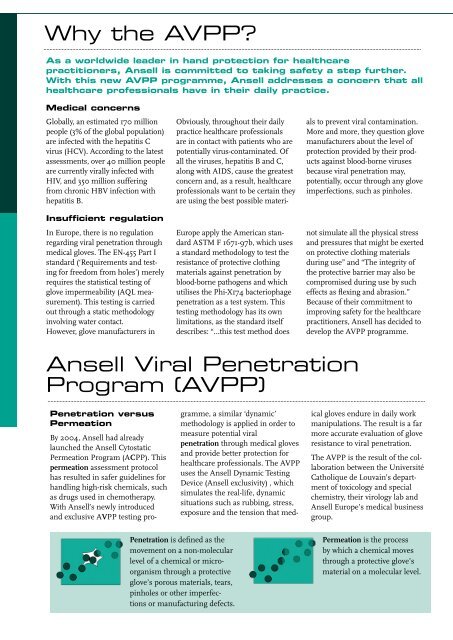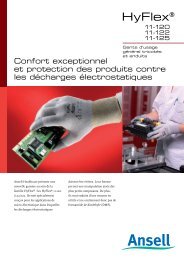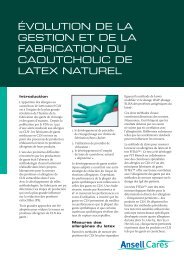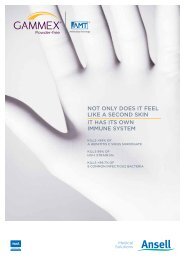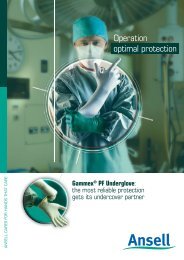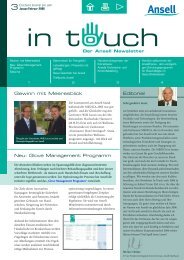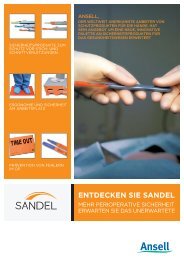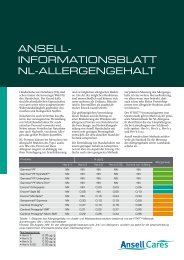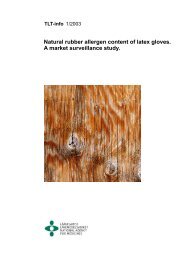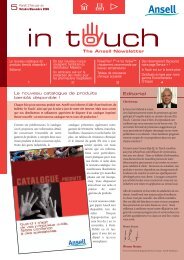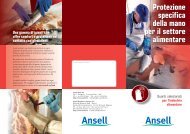AVPP: Ansell Viral Penetration Program - Ansell Healthcare Europe
AVPP: Ansell Viral Penetration Program - Ansell Healthcare Europe
AVPP: Ansell Viral Penetration Program - Ansell Healthcare Europe
Create successful ePaper yourself
Turn your PDF publications into a flip-book with our unique Google optimized e-Paper software.
Why the <strong>AVPP</strong>?<br />
As a worldwide leader in hand protection for healthcare<br />
practitioners, <strong>Ansell</strong> is committed to taking safety a step further.<br />
With this new <strong>AVPP</strong> programme, <strong>Ansell</strong> addresses a concern that all<br />
healthcare professionals have in their daily practice.<br />
Medical concerns<br />
Globally, an estimated 170 million<br />
people (3% of the global population)<br />
are infected with the hepatitis C<br />
virus (HCV). According to the latest<br />
assessments, over 40 million people<br />
are currently virally infected with<br />
HIV, and 350 million suffering<br />
from chronic HBV infection with<br />
hepatitis B.<br />
Insufficient regulation<br />
In <strong>Europe</strong>, there is no regulation<br />
regarding viral penetration through<br />
medical gloves. The EN-455 Part I<br />
standard (‘Requirements and testing<br />
for freedom from holes’) merely<br />
requires the statistical testing of<br />
glove impermeability (AQL measurement).<br />
This testing is carried<br />
out through a static methodology<br />
involving water contact.<br />
However, glove manufacturers in<br />
<strong>Ansell</strong> <strong>Viral</strong> <strong>Penetration</strong><br />
<strong>Program</strong> (<strong>AVPP</strong>)<br />
<strong>Penetration</strong> versus<br />
Permeation<br />
By 2004, <strong>Ansell</strong> had already<br />
launched the <strong>Ansell</strong> Cytostatic<br />
Permeation <strong>Program</strong> (ACPP). This<br />
permeation assessment protocol<br />
has resulted in safer guidelines for<br />
handling high-risk chemicals, such<br />
as drugs used in chemotherapy.<br />
With <strong>Ansell</strong>’s newly introduced<br />
and exclusive <strong>AVPP</strong> testing pro-<br />
Obviously, throughout their daily<br />
practice healthcare professionals<br />
are in contact with patients who are<br />
potentially virus-contaminated. Of<br />
all the viruses, hepatitis B and C,<br />
along with AIDS, cause the greatest<br />
concern and, as a result, healthcare<br />
professionals want to be certain they<br />
are using the best possible materi-<br />
<strong>Europe</strong> apply the American standard<br />
ASTM F 1671-97b, which uses<br />
a standard methodology to test the<br />
resistance of protective clothing<br />
materials against penetration by<br />
blood-borne pathogens and which<br />
utilises the Phi-X174 bacteriophage<br />
penetration as a test system. This<br />
testing methodology has its own<br />
limitations, as the standard itself<br />
describes: “…this test method does<br />
gramme, a similar ‘dynamic’<br />
methodology is applied in order to<br />
measure potential viral<br />
penetration through medical gloves<br />
and provide better protection for<br />
healthcare professionals. The <strong>AVPP</strong><br />
uses the <strong>Ansell</strong> Dynamic Testing<br />
Device (<strong>Ansell</strong> exclusivity) , which<br />
simulates the real-life, dynamic<br />
situations such as rubbing, stress,<br />
exposure and the tension that med-<br />
<strong>Penetration</strong> is defined as the<br />
movement on a non-molecular<br />
level of a chemical or microorganism<br />
through a protective<br />
glove’s porous materials, tears,<br />
pinholes or other imperfections<br />
or manufacturing defects.<br />
als to prevent viral contamination.<br />
More and more, they question glove<br />
manufacturers about the level of<br />
protection provided by their products<br />
against blood-borne viruses<br />
because viral penetration may,<br />
potentially, occur through any glove<br />
imperfections, such as pinholes.<br />
not simulate all the physical stress<br />
and pressures that might be exerted<br />
on protective clothing materials<br />
during use” and “The integrity of<br />
the protective barrier may also be<br />
compromised during use by such<br />
effects as flexing and abrasion.”<br />
Because of their commitment to<br />
improving safety for the healthcare<br />
practitioners, <strong>Ansell</strong> has decided to<br />
develop the <strong>AVPP</strong> programme.<br />
ical gloves endure in daily work<br />
manipulations. The result is a far<br />
more accurate evaluation of glove<br />
resistance to viral penetration.<br />
The <strong>AVPP</strong> is the result of the collaboration<br />
between the Université<br />
Catholique de Louvain’s department<br />
of toxicology and special<br />
chemistry, their virology lab and<br />
<strong>Ansell</strong> <strong>Europe</strong>’s medical business<br />
group.<br />
Permeation is the process<br />
by which a chemical moves<br />
through a protective glove’s<br />
material on a molecular level.


